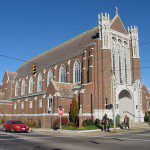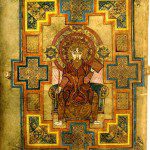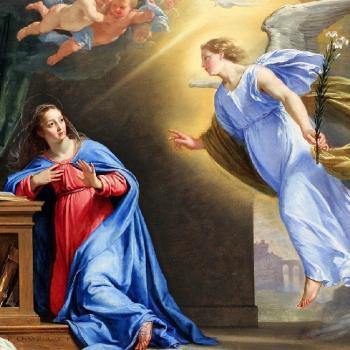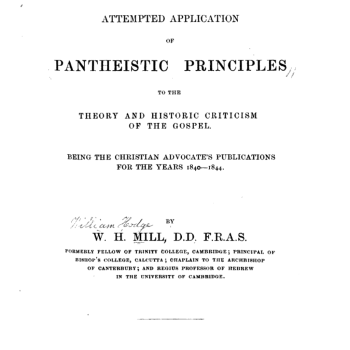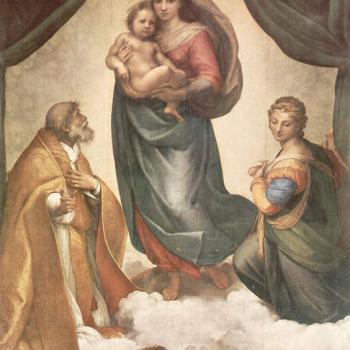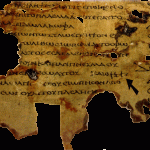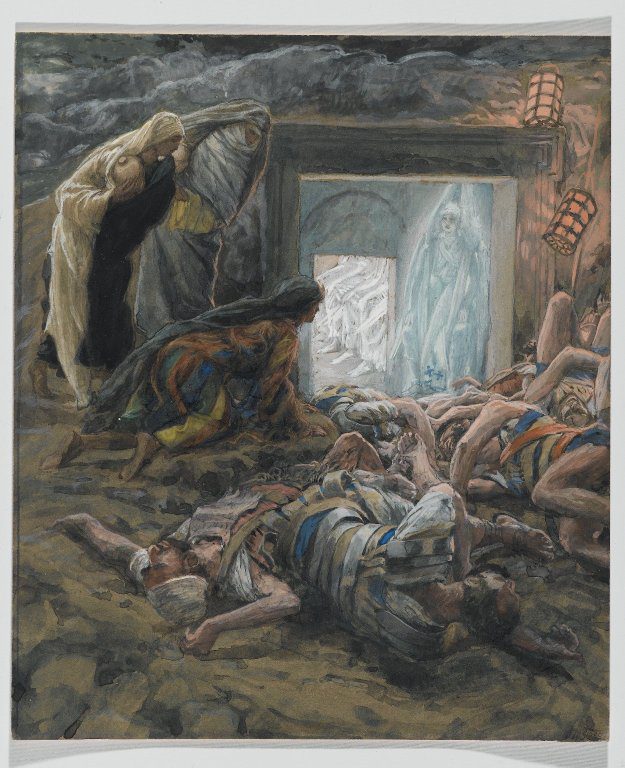
Mary Magdalene and the Holy Women at the Tomb, by James Tissot (1836-1902) [public domain / Wikimedia Commons]
***
My esteemed Presbyterian friend John E. Taylor argued for this equation in my Facebook combox. I believe I demonstrated that this is untrue; including citing eleven reputable Protestant scholars / scholarly works. His words will be in blue.
***
“Are you he who is to come, or shall we look for another?” (Matthew 11:3, Luke 7:19).
But which of US wouldn’t have been discouraged if we were rotting in jail and knew perfectly well Jesus could get us out but he didn’t?
Even Mary failed Him. It took me some putting together of the Synoptics off and on for several months, but I’m persuaded “the other Mary” (Matthew 28:1) was Jesus’ mother who with Mary Magdalene brought spices to the tomb. They didn’t believe our Lord when He said He would rise from the dead, and had to be admonished by the angel “Why do you seek the living among the dead?” (Luke 24:5)
We ALL have feet of clay – even Mary. ![]()
Dave, no challenge to what I said above about Mary’s failing Jesus? I’ve given it some further thought . . . I am confident Scripture places her at the tomb when he was buried — which is where we’d expect any mother to be at her child’s funeral.
It’s absurd that she failed Him. That’s self-refuting.
“But what saith the Scripture?” (Romans 4:3 KJV)
The naming of Jesus’ and Mary’s other family connections gives evidence that Mary was at the tomb on Easter Sunday NOT expecting him to have risen. Looking at the Gospels in order:
Matthew:
When Jesus was rejected at Nazareth:
Matthew 13:55 Is not this the carpenter’s son? Is not his mother called Mary? And are not his brothers James and Joseph and Simon and Judas?
During the crucifixion:
Matthew 27:55-56 There were also many women there, looking on from a distance, who had followed Jesus from Galilee, ministering to him, among whom were Mary Magdalene and Mary the mother of James and Joseph and the mother of the sons of Zebedee.
Matthew twice mentions “James and Joseph”. Who can doubt these are the same James and Joseph, therefore the same Mary?
5 verses later, immediately after Jesus’ burial:
Matthew 27:61 Mary Magdalene and the other Mary were there, sitting opposite the tomb.
The context mentions no other Mary. Her son has just been buried. **Where else** would you expect her to be??
And now, Easter Sunday:
Matthew 28:1 Now after the Sabbath, toward the dawn of the first day of the week, Mary Magdalene and the other Mary went to see the tomb.
Mark:
When Jesus was rejected in Nazareth:
Mark 6:3 Is not this the carpenter, the son of Mary and brother of James and Joses and Judas and Simon? And are not his sisters here with us?” And they took offense at him.
During the crucifixion:
Mark 15:40 There were also women looking on from a distance, among whom were Mary Magdalene, and Mary the mother of James the younger and of Joses, and Salome.
Mark twice says “James and Joses” instead of Matthew’s “James and Joseph”. Same two men, same Mary.
Immediately after Jesus’ burial:
Mark 15:47 Mary Magdalene and Mary the mother of Joses saw where he was laid.
Again, Mary is at the burial, where you’d EXPECT a mother to be.
Resurrection Sunday:
Mark 16:1 When the Sabbath was past, Mary Magdalene, Mary the mother of James, and Salome bought spices, so that they might go and anoint him.
Interesting how Mark mentions Joses in one verse and James in the next. But it’s clearly the same Mary.
Luke:
Watching the crucifixion and at the tomb:
Luke 23:49 And all his acquaintances and the women who had followed him from Galilee stood at a distance watching these things.
At the tomb:
Luke 23:55 The women who had come with him from Galilee followed and saw the tomb and how his body was laid.
Mary of course was from Nazareth of Galilee (and Matthew also mentions Galilee)
Resurrection Sunday:
Luke 24:1, 10 But on the first day of the week, at early dawn, they went to the tomb, taking the spices they had prepared…Now it was Mary Magdalene and Joanna and Mary the mother of James and the other women with them who told these things to the apostles,
Who else could this “James” be but the brother of Joseph (or Joses) in Matthew and Mark?
John:
John expressly places Mary at the Cross:
John 19:25 But standing by the cross of Jesus were his mother and his mother’s sister, Mary the wife of Clopas, and Mary Magdalene.
I don’t know why the only woman John mentions in his resurrection chapter is Mary Magdalene:
John 20:1 Now on the first day of the week Mary Magdalene came to the tomb early, while it was still dark, and saw that the stone had been taken away from the tomb.
Perhaps it was to avoid embarrassing Mary by telling the story (again) of her not believing Jesus would rise again. Jesus after all had designated her as John’s mother:
John 19:26-27 When Jesus saw his mother and the disciple whom he loved standing nearby, he said to his mother, “Woman, behold, your son!” Then he said to the disciple, “Behold, your mother!” And from that hour the disciple took her to his own home.
I would not want to repeat embarrassing incidents about family members even if they were well-known.
My point, Dave, is simple: Unless someone can show my exegesis to be wrong, Scripture locates Mary with Mary Magdalene bringing spices to anoint Jesus’ dead body. Why? Because they didn’t believe His promise to rise again.
No woman is so greatly respected by so many than Mary, but not even she was perfect, and Christ graciously corrected — and forgave — her unbelief.
Yes, it is incorrect exegesis. Mary the mother of Jesus would not repeatedly be called Mary the mother of Joseph and James, etc., nor would she be called “the other Mary.” Those scenarios are simply too bizarre to contemplate for the Theotokos.
I disproved this exegesis in 1996 in my first book, in arguing in favor of perpetual virginity. The assumption that James and Joseph are blood brothers of Jesus collapses under the following facts:
By comparing Matthew 27:56, Mark 15:40, and John 19:25, we find that James and Joseph — mentioned in Matthew 13:55 with Simon and Jude as Jesus’ “brothers” — are also called sons of Mary, wife of Clopas. This other Mary (Matthew 27:61, 28:1) is called our Lady’s adelphe in John 19:25 (it isn’t likely that there were two women named “Mary” in one family — thus even this usage apparently means “cousin” or more distant relative). Matthew 13:55-56 and Mark 6:3 mention Simon, Jude and “sisters” along with James and Joseph, calling all adelphoi. Since we know for sure at least James and Joseph are not Jesus’ blood brothers, the most likely interpretation of Matthew 13:55 is that all these “brothers” are cousins, according to the linguistic conventions discussed above. At the very least, the term brother is not determinative in and of itself.
Don’t wanna believe me? Okay, then consider what the Protestant International Standard Bible Encyclopedia states (article: “Mary”). It never once considers Mary mother of James and Joses as the Blessed Virgin Mary:
(2) A comparison of Mt 27:56; 28:1 with Mr 15:47 seems clearly to identify the “other” Mary with Mary the mother of Joses.
(3) Mr 15:40 identifies Mary the mother of James and Mary the mother of Joses (compare Mr 15:47) (see Allen’s note on Mt 27:56).
(4) At this point a special problem of identification arises. Mary, the wife of Clopas, is mentioned as being present at the cross with Mary the mother of Jesus, the latter’s sister and Mary of Magdala (Joh 19:25). In the other notices of the group at the cross, Mary, the mother of James, is mentioned (Mt 27:56; Mr 15:40). Elsewhere, James is regularly designated “son of Alpheus” (Mt 10:3; Mr 3:18; Lu 6:15). Since it can hardly be doubted that James, the apostle, and James the Less, the son of Mary, are one and the same person, the conclusion seems inevitable that Mary, the mother of James, is also the wife of Alpheus. Here we might stop and leave the wife of Clopas unidentified, but the fact that the name Alpheus (Alphaios) is the Greek transliteration of the Aramaic chalpay, together with the unlikelihood that anyone important enough to be mentioned by John would be omitted by the synoptists and that another Mary, in addition to the three definitely mentioned, could be present and not be mentioned, points to the conclusion that the wife of Clopas is the same person as the wife of Alpheus (see ALPHAEUS). Along with this reasonable conclusion has grown, as an excrescence, another for which there is no basis whatever; namely, that the wife of Clopas was the sister of Mary, the mother of Jesus. This would make the apostle James the cousin of Jesus, and, by an extension of the idea, would identify James, the apostle, with James, the “Lord’s brother.” The available evidence is clearly against both these inferences (see Mt 13:55; Mr 6:3; Ga 1:19). . . .
V. Mary, the Mother of James and Joses.
Under this caption it is necessary merely to recall and set in order the few facts concerning this Mary given in the Gospels (see Mt 27:55-56,61; Mr 15:40; 16:1; Lu 24:10; compare Lu 23:49-56).
In Mt 27:55-56 (parallel Mr 15:40), we are told that at the time of the crucifixion there was a group of women observing the event from a distance. These women are said to have followed Jesus from Galilee, ministering to Him and to the disciples. Among these were Mary Magdalene (see III , above); Mary, mother of James and Joses; and the unnamed mother of Zebedee’s children. By reference to Lu 8:2-3, where this group is first introduced, it appears that, as a whole, it was composed of those who had been healed of infirmities of one kind or another. Whether this description applies individually to Mary or not we cannot be sure, but it is altogether probable. At any rate, it is certain that Mary was one who persistently followed with the disciples and ministered of her substance to aid and comfort the Lord in His work for others. The course of the narrative seems to imply that Mary’s sons accompanied their mother on this ministering journey and that one of them became an apostle. It is interesting to note that two mothers with their sons joined the company of the disciples and that three out of the four became members of the apostolic group. Another item in these only too fragmentary references is that this Mary, along with her of Magdala and the others of this group, was of sufficient wealth and position to be marked among the followers of Jesus as serving in this particular way. The mention of Chuzas’ wife (Lu 8:3) is an indication of the unusual standing of this company of faithful women.
The other notices of Mary show her lingering late at the cross (Mr 15:40); a spectator at the burial (Mr 15:47); and among the first to bear spices to the tomb. This is the whole of this woman’s biography extant, but perhaps it is enough. We are told practically nothing, directly, concerning her; but, incidentally, she is known to be generous, faithful, loving, true and brave. She came in sorrow to the tomb to anoint the body of her dead Lord; she went away in joy to proclaim Him alive forevermore. A privilege to be coveted by the greatest was thus awarded to simple faith and trusting love.
Therefore, Mary Mother of Jesus did not go to the tomb to anoint Jesus. That means one can’t come up with that act as evidence that she disbelieved (before it occurred) in the Resurrection.
The New Bible Dictionary draws the same conclusions: never remotely hinting that this “other Mary” is the Blessed Virgin Mary.
John Calvin agrees, too, in his commentary on John 19:25:
Mary of Cleophas, and Mary Magdalene. He calls her either the wife or the daughter of Cleophas; but I prefer the latter interpretation. He says, that she was the sister of the mother of Jesus, and, in saying so, he adopts the phraseology of the Hebrew language, which includes cousins, and other relatives, under the term brothers.
He comments on Matthew 13:55 as follows:
The word brothers, we have formerly mentioned, is employed, agreeably to the Hebrew idiom, to denote any relatives whatever; and, accordingly, Helvidius displayed excessive ignorance in concluding that Mary must have had many sons, because Christ’s brothers are sometimes mentioned.
So where do you get your exegesis from? Even Calvin disagrees with it, and we know that he believed in Mary’s perpetual virginity, too (no blood brothers of Jesus!).
My exegesis is quite straightforward:
1) Among Jesus’ brothers/cousins there was a James and a Joseph/Joses;
2) Watching at the Crucifixion was a Mary, mother of James and Joseph/Joses who later appeared with spices to anoint Jesus’ body
3) To fit your tradition, you must presuppose a different Mary with two sons of the same name who also appeared with Mary on Good Friday.
Too many coincidences, just to satisfy a tradition that is neither expressly set forth in Scripture nor can by good and necessary consequence be deduced from Scripture.
It’s not just “my” Catholic tradition (implied eisegesis); it is solid Protestant biblical exegesis, as I demonstrated.
One passage alone refutes the whole theory: in 1996 I wrote: “This other Mary (Matthew 27:61, 28:1) is called our Lady’s adelphe in John 19:25.”
Again, it’s not just me who is observing the extreme weakness of this theory. It’s ISBD, New Bible Dictionary, and John Calvin.
The closest I could find to any support was the highly tentative statement of Eerdmans Bible Dictionary about the mother of James and Joses: “It is possible but not likely that this Mary was the same person as the mother of Jesus . . .” (p. 697).
You identify “the other Mary” with the Blessed Virgin Mary. Presbyterian commentator Matthew Henry doesn’t do that, at Matthew 27:56:
The company that attended the funeral; and that was very small and mean. Here were none of the relations in mourning, to follow the corpse, no formalities to grace the solemnity, but some good women that were true mourners—Mary Magdalene, and the other Mary, v. 56.
Likewise, in his comment on Matthew 28:1:
Who they were, that came to the sepulchre; Mary Magdalene and the other Mary, the same that attended the funeral, and sat over against the sepulchre, as before they sat over against the cross; still they studied to express their love to Christ; still they were inquiring after him. Then shall we know, if we thus follow on to know. No mention is made of the Virgin Mary being with them; it is probable that the beloved disciple, who had taken her to his own home, hindered her from going to the grave to weep there.
Expositor’s Greek Testament and Pulpit Commentary do the same for Matthew 27:61. No one seems to hold that Mary Mother of Jesus went to the tomb. Meyer’s NT Commentary and Pulpit Commentary take the same view of Matthew 28:1.
McClintock and Strong Biblical Cyclopedia equates Mary wife of Clopas with Mary mother of James and Joses, and “the other Mary.” There is no hint that this Mary is the Blessed Virgin.
Easton’s Bible Dictionary agrees as well:
Mary the wife of Cleopas is mentioned (Jhn 19:25) as standing at the cross in company with Mary of Magdala and Mary the mother of Jesus. By comparing Mat 27:56 and Mar 15:40, we find that this Mary and “Mary the mother of James the little” are on and the same person, and that she was the sister of our Lord’s mother. She was that “other Mary” who was present with Mary of Magdala at the burial of our Lord (Mat 27:61; Mar 15:47); and she was one of those who went early in the morning of the first day of the week to anoint the body, and thus became one of the first witnesses of the resurrection (Mat 28:1; Mar 16:1; Luk 24:1).
John W. Wenham wrote an excellent article in Evangelical Quarterly in 1975, titled, “The Relatives of Jesus.” He flatly denies your theory, and states:
The only clear reference to the mother of Jesus comes from John, who represents her as being near the cross for her son’s farewell and as being escorted from the scene before his death. The other three gospels say that the women watched from a distance and that at least two of the Marys witnessed the burial. The idea that one of these witnesses was the Lord’s mother is almost impossible to reconcile with John’s account of her being taken away “from that hour”. . . .
It has seemed natural to most readers to equate “Mary of Clopas” with “Mary the mother of James and/or Joses” and with “the other Mary”, not with the mother of Jesus. Indeed, seeing there were inescapably three Marys, it seems very odd that the Synoptists (who are quite ready to speak of the mother of Jesus) should identify her in such an obscure manner. The suggested explanations for this disguise seem laboured. In view of the fervid quest for texts to buttress the claims of Marian devotion, it is almost incredible that an appearance to the Lord’s mother on Easter Sunday morning should not have been recognized and seized upon, if such an appearance is in fact being recorded. The description “the other Mary” would provide only the flimsiest veil. That she was not so identified can only mean that there was no tradition to support such identification. . . .
If the equation of “the other Mary” with the mother of Jesus breaks down, then it is almost inevitable that she should be equated with Mary of Clopas.
I’ve now cited eleven Protestant scholarly sources, while you have cited exactly none in defense of your position. Do you have any scholarly support at all that you can cite? Or is this your own unique theory?
And not one of them addresses their inevitable conclusion that we have Mary the mother of Jesus and Mary the wife of Clopas. So far, so good. But each then has immediate family members (I would say “sons”) named James and Joseph/Joses, and Scripture locates them together at the Cross.
Incidentally, the conjecture that Clopas was the one going to Emmaus (Luke 24), and his traveling companion was his wife, is I think a good one, and no doctrines are at stake![]()
But do you really think one of John’s first acts as Mary’s new son was to “not allow” her to be at her son’s burial?!
I’ll ask a second time: “Do you have any scholarly support at all that you can cite? Or is this your own unique theory?”
Haven’t found any yet. Preparing to move to NC (new job) and have a lot on my plate.
Catholics don’t like my idea because it challenges Mary’s sinlessness, and Protestants don’t like it, either, because at least some of them mistakenly think Mary’s being at the tomb would give Catholics an excuse to venerate her (which you know it doesn’t!).
*****


